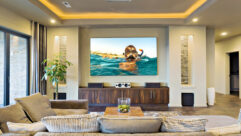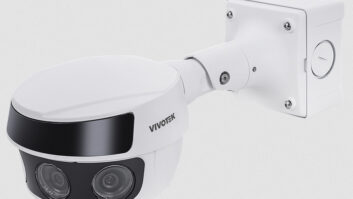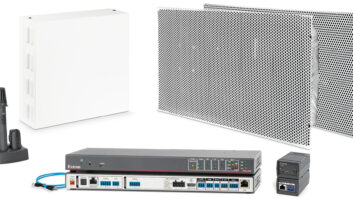
Stony Brook Arena AV Renovation
Jun 24, 2014 11:53 AM,
With Bennett Liles
Listen to the Podcast

Editor’s note: For your convenience, this transcription of the podcast includes timestamps. If you are listening to the podcast and reading its accompanying transcription, you can use the timestamps to jump to any part of the audio podcast by simply dragging the slider on the podcast to the time indicated in the transcription.

A multimillion-dollar renovation of Stony Brook University’s Stony Brook Arena called for a complete rebuild of the power system and Advance Sound Company of Farmingdale, N.Y., was called in for the work. Chief Operations Officer Thomas DePace is going to tell us about the installation using a Lyntec RPC 342 panel, coming up next on the SVC Podcast.
Thomas, thanks for joining us here on the SVC Podcast from Advance Sound Company. We haven’t done a podcast lately on a power system installation, and this is one that really shows where we are with power control and management now. But this completely new power system was actually part of a much bigger renovation of the university’s whole Stony Brook Arena.
That’s correct. The university had invested like $22.4 million in renovating the existing 4,000-seat arena for the men’s and women’s basketball teams, so Advanced Sound Company was involved in the broadcast cabling project, the cable RF distribution, the power upgrades, as well as the sound system replacement.
OK, well, you guys had a lot to do in there, but the one thing that’s basic to audio, video, and lighting is, of course, power, and for all the others to work right you have to get the power system right. For that all-important phase of the job you chose the Lyntec RPC controller panel, which I believe is among its newest models. Why did you decide to go with that one for this project?
We went with the Lyntec panel—the 342 stands for, you know, it’s a three-phase, 42-breaker or 42-slot power controller, and with an arena of this size, it called for about 25 amplifiers as well as scoreboards installed by Daktronics and video boards installed by Daktronics. We wanted to make sure that we had enough of the proper power, clean power. We wanted to make sure we had properly sequenced power, and we wanted to make sure that we were able to have motorized breakers to also save power when it came to saving money for the university, and the Lyntec panel really helped us achieve that. The panel that we put in actually has the Ethernet control in it, so it does give us some metrics in terms of measuring what we can do with the power, how much power consumption we’re using, what breakers are on, what breakers have failed and reset. So there are some great capabilities that augmented the overall project. [Timestamp: 2:47]
And of course a very basic step in the beginning of all that is just assessing what the load is going to be.
Exactly. I mean the arena is not just going to be used for basketball events. In the past, the arena has hosted the likes of concerts including Bruno Mars, and there is some company-powered connections for people to bring in staging and have the power all locally provided by the arena. The Lyntec panel is specifically focusing on the audio and video systems. [Timestamp: 3:19]
If there are just one or two devices or systems in there, that really represent the lion’s share of the power draw what would the biggest power users be?
I would say the audio equipment rack, which is drawing about 45,000W of audio is a true draw on the power system. It’s going to be a constant drawer. There are two video boards installed by Daktronics that will draw a good amount of power, but as everyone knows with LED technology, it’s using less and less power, but we wanted to make sure that we were covering that. We used 30-amp breakers for the video system. [Timestamp: 3:54]
I believe all of that is controlled ultimately with a Crestron touchpanel. How does the control system connect and operate?
When the project was originally designed, it didn’t have any control. We worked with Stony Brook University and their staff over there numerous times and what we felt is that they needed a way to monitor the power, to turn the power on and off, so we have a small Crestron MC3 processor connected to a small touchpanel that allows us to serve a couple of functions. One, it takes the metrics reported from the Lyntec panel and tells us how much power we’re actually using, and it also allows us to symbiotically control the audio processing as well as the motorized breakers. We have a Biamp digital signal processor in there—the new Tesira product—and we’re able to mute all of the amplifier channels as we’re powering up the system to make sure that we’re not overdriving the amplifiers, to make sure that we don’t blow out any speakers or voice coils or things like that. [Timestamp: 4:56]
Stony Brook Arena AV Renovation
Jun 24, 2014 11:53 AM,
With Bennett Liles

And this system will sense and deliver plenty of information about what’s going on with the power system. What specific things can you read from it while an event is going on?
The panel gives us any information that we truly desire. Like I said, it’s going to tell us every breaker that’s on. It’s going to tell us the actualized load on those breakers, and it’s going to tell us what’s available as well. I think we’re feeding it with either a three-pole 100 or a three-pole 60, and we just want to make sure that we’re monitoring that power and consuming that power in a great fashion in terms of the proper use and best practices in terms of power consumption. [Timestamp: 5:34]
One of the most interesting things about it is the remote control capability. What are the various options as far as remote monitoring and management?
In terms of the Lyntec panel itself, we have a very rudimentary momentary switch that will activate the power to a preset so that if a member of the athletic staff needs to come in and turn on a music source or a video source just for a practice or to really get amped up for a game, there is the capability to turn that momentary switch. There is also the Crestron control panel, which is tied in with their iPad application as well as their X panel, and those allow us to see some reporting, and with the Ethernet module, allows us to connect into the panel directly using the IP address. [Timestamp: 6:22]
Okay, and all of that is networked. I was just wondering if you have serial RS-232 or any of the older types of interface with it?
No, no. Once you go to the Ethernet control, most newer processors are allowing us to just go right into Ethernet based. There are some other options where you can switch to an RS-232 or RS-45-type of connection, but we wanted to make sure, especially with the types of products we were putting in this installation, that we were constantly moving our customer forward with technology. [Timestamp: 6:55]
I know this was a big renovation and a lot of people were working on it. What kind of window did you have? How long did it take for you to get this all in and tested?
Well, the arena did close for a period of time as they did the entire project renovation and they moved into a smaller gymnasium actually. As they got better and made their tournament playoffs, they really pushed the timeline on this. The project was awarded early last year and did not really begin until about September, so between September and March was a real push for us. We had the Lyntec panel on there as soon as the dust had cleared and we made sure that we were up and running for their playoff run if they needed it. [Timestamp: 7:42]
One of the key parts of planning this job had to be planning the time and people on it. What really took most of the time, the most time-consuming part of it?
In terms of the installation itself, on the power side, it’s fairly simple. The building of the equipment racks in the office are fairly simple as well. It’s really just a matter of making sure that everything is properly tested and tuned and put through its paces because along with the power and the sound system and the video system, we also were involved in the broadcast cabling. Stony Brook University, although it’s a large university [and] has an excellent academic track record, it is really not that well known for their athletics. When we did the broadcast cabling job, there had to be provisions for triax, SDI, fiber. There were a lot of different connections to make sure that all different types of trucks and production vehicles could come in and connect to this system. Testing point to point and making sure everything was perfect for the installation and usage was the way to be. [Timestamp: 8:47]
And that can be the tedious but very important part of the work just having people going through it cable by cable and ringing out all of the connections one by one. But you got this one done. They got the stable power foundation they needed for Stony Brook Arena so what up for Advance Sound Company now? What kind of stuff have you got coming up?
Oh, well, we do a lot of K-12 installations as well as municipalities. I actually just came back from a meeting with the NYPD and we will be upgrading their Crestron digital media systems in their emergency operations and CompStat area as well as their theater. That’s probably the next notable project that we’ll be jumping in and I can’t wait to get that started this summer. [Timestamp: 9:30]
All right, Thomas. It’s been great hearing about this one. And as I mentioned before, we haven’t done a lot of power installations on the podcast and this really shows us how far things have come with that. Thomas DePace, Chief Operations Officer with Advance Sound Company, thanks for telling us about this one.
Well, thank you for having me.










